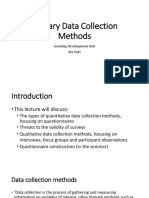0 ratings0% found this document useful (0 votes)
17 viewsLecture 10 Basic Survey Formats
Uploaded by
Anwar shahCopyright
© © All Rights Reserved
Available Formats
Download as PDF, TXT or read online on Scribd
0 ratings0% found this document useful (0 votes)
17 viewsLecture 10 Basic Survey Formats
Uploaded by
Anwar shahCopyright
© © All Rights Reserved
Available Formats
Download as PDF, TXT or read online on Scribd
You are on page 1/ 16
Basic Survey Formats
Lecture 10
Department of Psychology AWKUM
SELF-ADMINISTERED QUESTIONNAIRE
A self-administered questionnaire is a structured form
that consists of a series of closed-ended and open-
ended questions. It is called self-administered as the
respondents fill it in themselves, without an
interviewer.
Closed-ended questions have a list of possible options
listed, from which the respondents must choose - these
can be pre-coded. Open-ended questions permits any
answer that the respondent thinks is appropriate and
should be recorded in the respondents' own words.
These need to be coded after all the possible responses
and assigned themes have been read.
Self administered Web Questionnaire
A self-administered questionnaire (also referred to
as a mailed questionnaire) is a data collection tool
in which written questions are presented that are to
be answered by the respondents in written form.
A written questionnaire can be administered in
different ways, for example:
Sending questionnaires by mail with clear
instructions on how to answer the questions and
requests for mailed responses;
Gathering all or part of the respondents in one
place at one time, giving oral or written
instructions, and letting the respondents fill out the
questionnaires; or
Hand-delivering questionnaires to respondents and
collecting them later.
Electronic Method of Self-Administered
Questionnaire Method
In recent times, electronic surveys can be
conducted by e-mail or administered on the
Internet or the Web (Malhotra, 2007).
E-mail interviews
To conduct an e-mail survey, a list of e-mail
addresses is prepared. The survey is posted within
the body of the e-mail message. The e-mails are
then sent out over the Internet.
Advantages of Self-administered
Questionnaire
Considerably low cost
The economy is one of the most obvious
benefits of a mailed questionnaire. The mail
questionnaire does not require a trained staff of
interviewers and supervisors; all it requires is
the cost of planning, sampling, duplicating,
mailing, and providing self-addressed
envelopes for the returns.
Ease in locating respondents
Except in extreme cases, locating respondents in a
mailed questionnaire survey is sometimes easier,
especially if the survey is conducted with specialized
and homogeneous samples.
Saving of time
The mailed questionnaire can be sent to all respondents
simultaneously, and most of the replies will be
received within a week or so. It is, however, also true
that final returns may take several weeks or longer.
Respondent’s convenience
The respondent may devote total time on it than he
or she can do so in an interview study. This
convenience may help him or her to answer more
correctly. Also, this gives him or her more time to
deal with difficult questions.
Greater anonymity
The absence of an interviewer provides the
respondent with greater anonymity. This makes him
or her more willing to provide socially undesirable
answers or answers that violate norms.
Less chance of biasing error
There is no opportunity for the respondent to be biased
by the presence of an interviewer. The personal
characteristics of the interviewer and the variability of
their skills may result in the biasing effect.
Disadvantages of Self-administered
Questionnaire
Limitations of the questionnaire
The only short and straightforward questionnaire with
a few complex, open-ended, screening, and/or tedious
questions can be used so that the respondents can
understand with the help of the printed instructions and
definitions.
Low response rate
The greatest disadvantage of the mailed questionnaire is
its low response rate. Mailed studies sometimes receive a
response rate of as low as 10 percent, and 50 percent is
considered adequate.
Inflexibility
The answers received in a mailed questionnaire have
to be accepted as final, because there remains no
scope to probe beyond the given answer to clarify an
ambiguous one, to overcome unwillingness to answer
a particular answer.
Verbal behavior
There is no interviewer present to observe non-verbal
behavior or to make personal assessments of the
respondent’s social class or other pertinent
characteristics. A lower-class respondent may pass
himself off as upper class in a mailed questionnaire,
with no challenge from an interviewer.
Telephone Surveys:
Telephone survey are a method of data collection
wherein interviewers contact respondents via
telephone to conduct an interview by asking the
respondent a list of different questions from a
questionnaire.
Advantages of phone-based interviewing
Research can be gathered quickly because phone
interviews are immediate and skilled interviewers
can complete a lot of surveys in a day of work.
Most people have telephones, so you have an ample
audience for gathering a representative sample to
complete the survey.
Disadvantages of a phone survey
Sometimes telephone calls are perceived as
telemarketing and thus negatively received by potential
respondents. This might influence your response rate.
It can be challenging to design an effective phone
survey because the questions need to be short and
precise for easy comprehension.
Face-to-face interview
Face-to-face interview is a data collection method
when the interviewer directly communicates with
the respondent in accordance with the prepared
questionnaire.
This method enables to acquire factual
information, evaluations, attitudes, preferences and
other information coming out during the
conversation with the respondent. Thus, face-to-
face interview method ensures the quality of the
obtained data and increases the response rate.
You might also like
- Foreign Exchange Options and Risk Management - Market Dynamics, Models and Human BehaviourNo ratings yetForeign Exchange Options and Risk Management - Market Dynamics, Models and Human Behaviour408 pages
- Modes of Administration of QuestionnaireNo ratings yetModes of Administration of Questionnaire6 pages
- Research Methodology: (Research Methods/Design/Technique)No ratings yetResearch Methodology: (Research Methods/Design/Technique)25 pages
- Advantages and Disadvantages of The Survey Method100% (2)Advantages and Disadvantages of The Survey Method5 pages
- Statistical Studies: Prepared by Ms. L. BridglalNo ratings yetStatistical Studies: Prepared by Ms. L. Bridglal20 pages
- Surveys: Surveys As A Respondent For Information Using Verbal or Written QuestioningNo ratings yetSurveys: Surveys As A Respondent For Information Using Verbal or Written Questioning47 pages
- Designing Effective Survey Instruments: DefinitionsNo ratings yetDesigning Effective Survey Instruments: Definitions11 pages
- Explain The Advantages and Disadvantages of The Following Types of Survey: 1. Mail and Self-Administered QuestionnairesNo ratings yetExplain The Advantages and Disadvantages of The Following Types of Survey: 1. Mail and Self-Administered Questionnaires2 pages
- Week 5, Unit 1 Questionnaires and Structured InterviewsNo ratings yetWeek 5, Unit 1 Questionnaires and Structured Interviews61 pages
- Communicating With Respondents: - Self-Administered Questionnaires - Telephone Interviews - Personal InterviewsNo ratings yetCommunicating With Respondents: - Self-Administered Questionnaires - Telephone Interviews - Personal Interviews47 pages
- Ch09 Survey Research Basic Communication MethodNo ratings yetCh09 Survey Research Basic Communication Method48 pages
- In This Type of Interview, The Respondents Answer The Questions Based On What TheyNo ratings yetIn This Type of Interview, The Respondents Answer The Questions Based On What They6 pages
- Surveys/questionnaires: How To Conduct A SurveyNo ratings yetSurveys/questionnaires: How To Conduct A Survey25 pages
- S Urveys: - If The Time Frame Is From Jan.1 - Dec.31 (What Crime Have You Been A Victim Of)No ratings yetS Urveys: - If The Time Frame Is From Jan.1 - Dec.31 (What Crime Have You Been A Victim Of)10 pages
- Data-Collection-and-Sampling-TechniquesNo ratings yetData-Collection-and-Sampling-Techniques73 pages
- Ms. Humaira Erum: "Assignment" "Business Research Methods"No ratings yetMs. Humaira Erum: "Assignment" "Business Research Methods"23 pages
- Master IELTS Reading (General): Tips, Readings, and Practice QuestionsFrom EverandMaster IELTS Reading (General): Tips, Readings, and Practice QuestionsNo ratings yet
- HUDCC Guidelines For Identification of Lots and Sites For Socialized HousingNo ratings yetHUDCC Guidelines For Identification of Lots and Sites For Socialized Housing6 pages
- Dying A Social Perspective On The End of Life Alex Broom Download PDF100% (8)Dying A Social Perspective On The End of Life Alex Broom Download PDF65 pages
- Systems Analysis and Design 11th Edition Tilley Test Bank PDF Download Full Book with All Chapters100% (9)Systems Analysis and Design 11th Edition Tilley Test Bank PDF Download Full Book with All Chapters40 pages
- Development Programs in S&T in The PhilippinesNo ratings yetDevelopment Programs in S&T in The Philippines3 pages
- Alison Smith, "Buñuel's Improbable Cast of Female Characters in - The Milky Way - "100% (1)Alison Smith, "Buñuel's Improbable Cast of Female Characters in - The Milky Way - "15 pages
- 1686631159.8276825 - RINGSHINE 2021-2022 AnnualNo ratings yet1686631159.8276825 - RINGSHINE 2021-2022 Annual82 pages
- Copyreading and Headline Writing - Samantha F. Batalla100% (1)Copyreading and Headline Writing - Samantha F. Batalla56 pages
- Foreign Exchange Options and Risk Management - Market Dynamics, Models and Human BehaviourForeign Exchange Options and Risk Management - Market Dynamics, Models and Human Behaviour
- Research Methodology: (Research Methods/Design/Technique)Research Methodology: (Research Methods/Design/Technique)
- Surveys: Surveys As A Respondent For Information Using Verbal or Written QuestioningSurveys: Surveys As A Respondent For Information Using Verbal or Written Questioning
- Designing Effective Survey Instruments: DefinitionsDesigning Effective Survey Instruments: Definitions
- Explain The Advantages and Disadvantages of The Following Types of Survey: 1. Mail and Self-Administered QuestionnairesExplain The Advantages and Disadvantages of The Following Types of Survey: 1. Mail and Self-Administered Questionnaires
- Week 5, Unit 1 Questionnaires and Structured InterviewsWeek 5, Unit 1 Questionnaires and Structured Interviews
- Communicating With Respondents: - Self-Administered Questionnaires - Telephone Interviews - Personal InterviewsCommunicating With Respondents: - Self-Administered Questionnaires - Telephone Interviews - Personal Interviews
- In This Type of Interview, The Respondents Answer The Questions Based On What TheyIn This Type of Interview, The Respondents Answer The Questions Based On What They
- S Urveys: - If The Time Frame Is From Jan.1 - Dec.31 (What Crime Have You Been A Victim Of)S Urveys: - If The Time Frame Is From Jan.1 - Dec.31 (What Crime Have You Been A Victim Of)
- Ms. Humaira Erum: "Assignment" "Business Research Methods"Ms. Humaira Erum: "Assignment" "Business Research Methods"
- Master IELTS Reading (General): Tips, Readings, and Practice QuestionsFrom EverandMaster IELTS Reading (General): Tips, Readings, and Practice Questions
- HUDCC Guidelines For Identification of Lots and Sites For Socialized HousingHUDCC Guidelines For Identification of Lots and Sites For Socialized Housing
- Dying A Social Perspective On The End of Life Alex Broom Download PDFDying A Social Perspective On The End of Life Alex Broom Download PDF
- Systems Analysis and Design 11th Edition Tilley Test Bank PDF Download Full Book with All ChaptersSystems Analysis and Design 11th Edition Tilley Test Bank PDF Download Full Book with All Chapters
- Alison Smith, "Buñuel's Improbable Cast of Female Characters in - The Milky Way - "Alison Smith, "Buñuel's Improbable Cast of Female Characters in - The Milky Way - "
- Copyreading and Headline Writing - Samantha F. BatallaCopyreading and Headline Writing - Samantha F. Batalla































































































